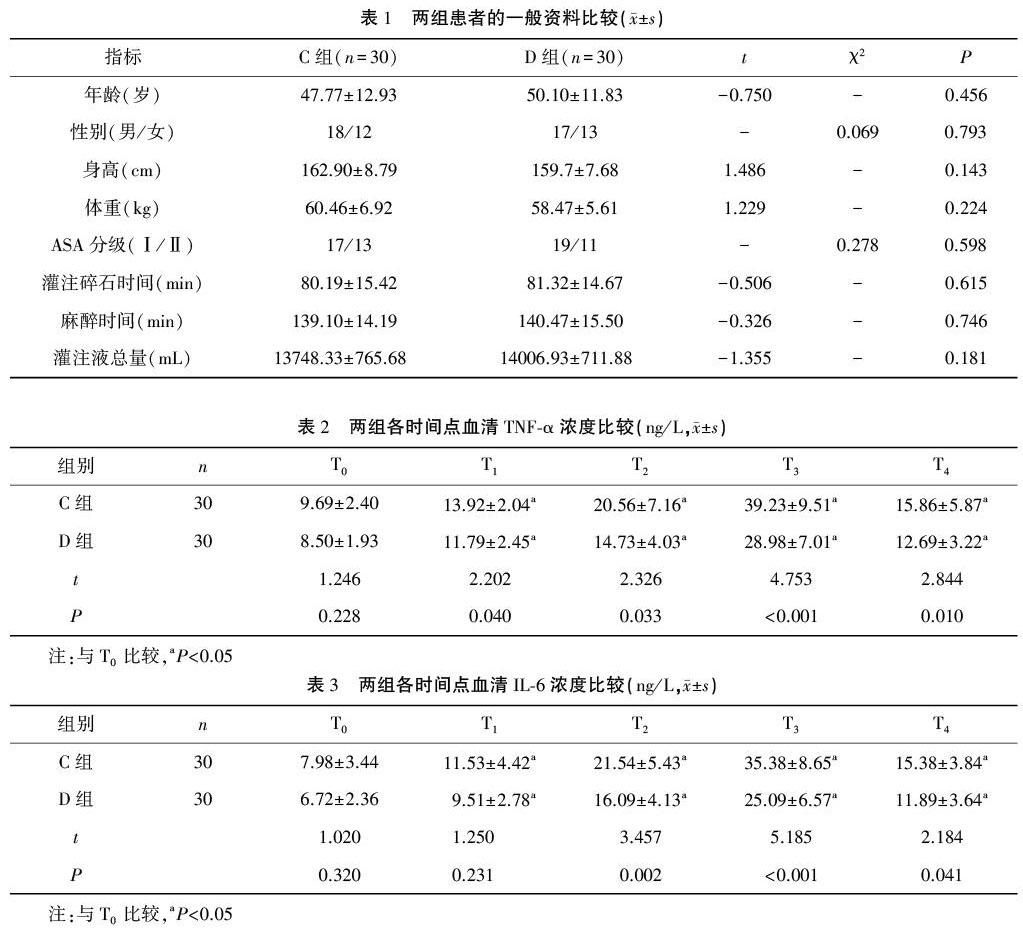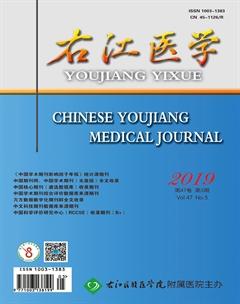右美托咪定对经皮肾镜碎石术患者炎症因子的影响
曾涟 谭宝乐 阳丽云 陆红文


【摘要】 目的 探討静脉输注右美托咪定对经皮肾镜碎石术患者围术期血清炎症因子水平的影响。方法 选择全身麻醉经皮肾镜碎石术患者60例,随机分为2组:右美托咪定组(D组)和对照组(C组),每组30例。D组:麻醉诱导开始以0.4 μg/(kg·h)的速率泵注右美托咪定至手术结束前30 min停止。C组:相同时点和速率泵注生理盐水。根据BIS值调整瑞芬太尼和丙泊酚的用量。记录患者年龄、性别比、身高、体重、ASA分级、灌注碎石时间、麻醉时间、灌注液总量等基本情况。抽取静脉血,用酶联免疫吸附法(ELISA)测定麻醉诱导前(T0)、灌注碎石30 min(T1)、灌注碎石术毕(T2)、术后4小时(T3)、术后24小时(T4)的TNF-α、IL-6、IL-10的浓度。结果 两组患者年龄、性别比、身高、体重、ASA分级、灌注碎石时间、麻醉时间、灌注液总量等指标比较差异无统计学意义(P>0.05)。两组患者T0 时点TNF-α、IL-6、IL-10浓度差异无统计学意义(P>0.05)。与T0时点比较,两组T1、T2、T3、T4的TNF-α、IL-6及IL-10浓度均显著升高(P<0.05)。与C组比较,D组T1、T2、T3、T4时TNF-α浓度均显著降低(P<0.05),T2、T3、T4时IL-6浓度均显著降低(P<0.05),T2、T3、T4时IL-10浓度显著升高(P<0.05)。结论 围术期静脉输注右美托咪定能减轻经皮肾镜碎石术患者的炎症反应,降低促炎因子TNF-α、IL-6的表达,提高抗炎因子IL-10的表达。
【关键词】 右美托咪定;经皮肾镜碎石术;炎症因子;TNF-α;IL-6;IL-10
中图分类号:R614.2+4 文献标志码:A DOI:10.3969/j.issn.1003-1383.2019.05.005
【Abstract】 Objective To investigate the effect of intravenous infusion of dexmedetomidine on the levels of inflammatory factors in patients undergoing percutaneous nephrolithotomy.Methods A total of 60 patients undergoing percutaneous nephrolithotomy under general anesthesia were selected,and they were randomly divided into dexmedetomidine group(group D) and control group(group C),with 30 cases in each group.The group D were given the injection of dexmetomidine at a rate of 04 μg/(kg·h) at the beginning of anesthesia induction and stopped 30 min before the end of the operation,while the group C were intravenously injected with an equal rate of physiological saline at the same time point.The doses of propofol and remifentanil were adjusted according to BIS values during the surgery.And then,basic information of the patients such as age,sex ratio,height,weight,ASA classification,perfusion lithotripsy time,anaesthesia time and total amount of perfusion fluid were recorded.In addition,venous blood were taken,and the concentrations of TNF-a,IL-6 and IL-10 before induction of anesthesia(T0),at 30 min after the start of lithotripsy(T1),at the end of lithotripsy(T2),at 4 hours after the end of surgery(T3) and 24 hours after the end of surgery(T4) were measured by enzyme-linked immunosorbent assay(ELISA).Results There were no statistically significant differences between indexes of the patients such as age,sex ratio,height,weight,ASA classification,perfusion lithotripsy time,anaesthesia time and total amount of perfusion fluid between the two groups(P>0.05).There were no statistically significant differences in the concentrations of TNF-α,IL-6 and IL-10 between the two groups at T0(P>005),while the TNF-α,IL-6 and IL-10 concentrations significantly increased in the two groups at T1,T2,T3 and T4 compared with those at T0(P<0.05).Compared with that in the group C,the concentration of TNF-α significantly decreased in the group D at T1,T2,T3 and T4 (P<0.05),the concentration of IL-6 significantly decreased at T2,T3 and T4(P<0.05),and the concentration of IL-10 significantly increased at T2,T3 and T4(P<0.05).Conclusion Intravenous infusion of dexmedetomidine during the perioperative period can alleviate inflammatory responses in patients undergoing percutaneous nephrolithotomy,reduce the expressions of pro-inflammatory factors TNF-α and IL-6 significantly,and increase the expression of the anti-inflammatory factor IL-10.
【Key words】 dexmedetomidine;percutaneous nephrolithotomy;inflammatory factor;TNF-α;IL-6;IL-10
国外相关报道显示[1],全世界泌尿系结石发生率高达14.8%且在不断上升,在最初发病的5年内复发率高达50%以上。由于经皮肾镜碎石术(percutaneous nephrolithotomy,PCNL)治疗效果好,术后复发率相对小,已成为目前肾内结石治疗的主要方法。PCNL创伤小,机体应激反应小,但长时间大量高压灌洗液的冲洗,对机体造成内环境紊乱,并引起一系列炎症反应。右美托咪定(dexmedetomidine,Dex)是一种新型的α2肾上腺受体激动剂,不仅具有镇静、镇痛、对呼吸影响小、抑制应激等作用,还具有抗炎特点[2]。本研究观察Dex对经皮肾镜碎石术患者围术期炎症因子的影响,探讨其在围术期的应用价值。
1 资料与方法1.1 临床资料 选择我院2017年3月~2018年9月择期在全麻下行经皮肾镜碎石术患者60例。纳入标准:(1)符合肾结石的诊断标准;(2)年龄在25岁至65岁之间;(3)ASA分级Ⅰ~Ⅱ级;(4)BMI 185~23.9 kg/m2。排除标准:(1)严重的脑、心、肝、肺及肾功能障碍者,Ⅱ~Ⅲ度房室传导阻滞、高血压病史、低血压病史、代谢相关性疾病、全身感染患者;(2)孕妇及哺乳期妇女;(3)对右美托咪定过敏的患者。随机分为2组:Dex组(D组)和对照组(C组),每组30例。
1.2 麻醉方法
1.2.1 麻醉监测 患者入手术室,开放外周静脉,监测心电图(ECG)、无创血压(NIBP)、脉搏血氧饱和度(SpO2)、脑电双频指数(BIS)。超声引导下局麻行右侧颈内静脉及桡动脉穿刺置管,并抽取3 mL静脉血于试管中,待测炎症因子TNF-α、IL-6、IL-10浓度。
1.2.2 麻醉诱导 Dex按照4 μg/mL规格进行配置,D组麻醉诱导时开始以0.4 μg/(kg·h)的速率静脉泵入Dex,C组相同时间点和速率静脉泵入生理盐水。麻醉诱导采用血浆靶控输注(TCI)方式,丙泊酚2.5~3.0 μg/mL、瑞芬太尼2.5~3.0 ng/mL,待效应浓度达到平衡时,BIS值若仍高于60,按0.2 μg/mL逐级加量丙泊酚至BIS值在40~55之间,患者睫毛反射消失后静脉注射顺式阿曲库铵0.25 mg/kg及芬太尼0.1 mg,肌肉松弛后行气管插管。机械控制呼吸,潮气量6~8 mL/kg,频率12~14次/分,PETCO2维持在35~45 mmHg之间,氧流量1.0 L/min,空气流量1.0 L/min。
1.2.3 麻醉维持 D组输注Dex维持剂量0.4 μg/(kg·h),C组静脉输注相同速率的生理盐水。根据患者生命征和BIS值调整丙泊酚和瑞芬太尼浓度,BIS值应保持在40~60之间。术中根据PETCO2和血气CO2分压调整呼吸参数。患者HR小于50次/分时静脉注射阿托品0.3 mg;血压低于基础值的30%时静脉注射麻黄碱5 mg;血压高于基础值的30%时追加乌拉地尔5 mg;当出现HR大于100次/分时追加艾司洛尔10 mg,必要时重复。手术结束前30 min,停止使用Dex和生理盐水,静脉注射芬太尼0.1 mg及盐酸托烷司琼5 mg。
1.3 观察指标 记录年龄、性别比、身高、体重、ASA分级、灌注碎石时间、麻醉时间和灌注液总量等基本情况。
1.4 血液指标
1.4.1 样本采集 采集患者麻醉诱导前(T0)、灌注碎石30 min(T1)、灌注碎石结束(T2)、术后4小时(T3)、术后24小时(T4)静脉血,全血标本置于室温2小時或4℃冰箱过夜于3000转/分,离心10分钟,取上清液存放于-20℃冰箱冰冻保存,应避免反复冻融。检测标本前需再次离心。
1.4.2 指标检测 采用双抗体夹心酶联免疫吸附法(ELISA)测定标本中人血清TNF-α、IL-6及IL-10的含量。
1.5 统计学方法 采用SPSS 25.0软件进行统计分析,计量资料符合正态分布且方差齐,以均数±标准差(±s)表示,独立样本t检验用于组间比较,重复测量数据的方差分析用于组内比较,检验水准:α=0.05,双侧检验。
2 结 果2.1 一般资料 两组患者年龄、性别比、身高、体重、ASA分级、灌注碎石时间、麻醉时间、灌注液总量等指标比较差异无统计学意义(P>0.05)。见表1。
2.2 右美托咪定对患者血清TNF-α、IL-6和IL-10浓度的影响 两组患者T0 时点TNF-α、IL-6、IL-10浓度差异无统计学意义(P>0.05),与T0时点比较,两组T1、T2、T3、T4时点TNF-α、IL-6及IL-10浓度均显著升高(P<0.05)。与C组比较,D组T1、T2、T3、T4时TNF-α浓度均显著降低(P<0.05),T2、T3、T4的IL-6浓度均显著降低(P<0.05),T2、T3、T4的IL-10浓度显著升高(P<0.05)。见表2、3、4。
3 讨 论 泌尿系结石是一种常见的疾病,发生率和复发率高。为了保证术中视野的清晰,PCNL需要输注大量的灌洗液冲洗肾盂和肾盏等泌尿系统,细菌及其内外毒素随着灌洗液通过肾盂静脉、肾盂小管、肾盂淋巴等途径逆流进入血液循环中,导致患者容量超负荷及炎症介质释放。麻醉及手术相关操作刺激也会引起大量炎症因子的释放。PCNL术后引起的并发症有发热、感染等,严重时甚至发生尿源性脓毒症性休克。因此,积极采取措施提高血流动力学的稳定性,减少围术期炎症因子或炎症介质的过度激活、释放,对患者安全度过围术期,降低术后并发症的发生起着重要作用。
Dex是一種新型的高选择性α2肾上腺受体激动剂,不仅具有镇静、镇痛、抑制交感神经兴奋等作用,还能降低炎症因子或炎症介质的释放,抑制炎症反应的发生,减少因过度炎症反应引起的机体损害。TNF-α是机体损伤或感染早期宿主反应最强的主要细胞因子,具有广泛的生物学功能,可诱导其他炎症因子的产生,引起炎症的级联反应[3]。IL-6是机体受到手术、麻醉等创伤应激时最重要和最敏感的标志物之一,与手术创伤程度密切相关[4]。IL-10是一种重要的抗炎因子,具有抑制炎症反应和免疫抑制的作用,在机体免疫调节中占主要的环节,不仅能抑制部分促炎因子的释放,而且促进抗炎介质的释放,减轻炎症反应。因此本研究选取TNF-α、IL-6、IL-10作为经皮肾镜碎石术患者围术期炎症反应的监测指标。
本研究选择PCNL患者,通过探讨Dex对患者围术期血清TNF-α、IL-6、IL-10的影响,来观察Dex对炎症因子的影响。根据结果推测Dex具有抑制炎症反应的作用。有研究显示,麻醉诱导前15 min静脉输注Dex负荷剂量1.0 μg/kg,维持剂量0.5 μg/(kg·h)同样可降低患者围术期TNF-α、IL-6水平,减少术后发热、全身炎症反应综合征等并发症,提高生存率[5]。Dex联合持续正压通气可减轻老年患者在胸外科手术中单肺通气时肺组织的氧化应激和炎症反应,从而降低术后并发症的发生率[6]。在肝硬化患者中使用Dex进行辅助麻醉,可以减轻应激反应,降低炎症因子水平,而不影响免疫功能,具有临床意义[7]。在动物实验研究中,Jiang等[8]研究Dex对肺缺血再灌注损伤的影响,肺缺血前静脉输注Dex 2.5 μg/(kg·h)可减轻肺组织损伤,显著降低支气管肺泡灌洗液中TNF-α、IL-6和MCP-1的浓度,右美托咪定预处理可抑制由肺缺血再灌注损伤引起的炎症反应。在内毒素血症的大鼠模型中,研究结果证实静脉输注Dex负荷剂量1 μg/kg、维持剂量50 μg/(kg·h)可降低大鼠体内TNF-α、IL-6、IL-8、IL-1β水平,升高IL-10水平,减轻炎症反应[9]。Wang等[10]研究也证实,在单肺通气前15分钟开始输注Dex 5 μg/(kg·h)可降低TNF-α、IL-6水平,升高IL-10水平,减轻炎症反应、减少肺损伤。上述的研究结果与本文研究结果相符。但Dex抗炎机制仍需进一步研究,可能与抑制Toll样受体4-核因子κB的抗炎途径、激活胆碱能抗炎通路、抑制单核巨噬细胞及小胶质细胞炎症因子的表达,以及镇痛作用等有关。
综上所述,本研究表明围术期输注Dex能明显降低促炎因子TNF-α、IL-6的表达,升高抗炎因子IL-10的水平,减轻PCNL患者的炎症反应,为经皮肾镜碎石术患者麻醉辅助药物右美托咪定的使用提供一定的临床依据。
参 考 文 献
[1] Khan SR,Pearle MS,Robertson WG,et al.Kidney stones[J].Nat Rev Dis Primers,2016,2:16008.
[2] McMorrow SP,Abramo TJ.Dexmedetomidine sedation:uses in pediatric proce dural sedation outside the operating room[J].Pediatr Emerg Care,2012,28(3):292-296.
[3] 李杰宾,杜庆霞,丁 宁,等.右美托咪定对大鼠心肺复苏后早期炎性因子释放的影响[J].中国医药,2015,10(9):1278-1281.
[4] Hunter CA,Jones SA.IL-6 as a keystone cytokine in health and disease[J].Nature Immunology,2015,16(5):448-457.
[5] Deng Y,Tan F,Gan X,et al.Perioperative application of dexmedetomidine for postoperative systemic inflammatory response syndrome in patients undergoing percutaneous nephrolithotomy lithotripsy:results of a randomised controlled trial[J].BMJ open,2018,8(11):e019008.
[6] Lin J,Li JB,Lu Z.Clinical application and effect of dexmedetomidine in combination with continuous positive airway pressure on one-lung ventilation in lung surgery of elder patients[J].Pakistan journal of pharmaceutical sciences,2018,31(6):2879-2883.
[7] Wang L,Zhang A,Liu W,et al.Effects of dexmedetomidine on perioperative stress response,inflammation and immune function in patients with different degrees of liver cirrhosis[J].Experimental and therapeutic medicine,2018,16(5):3869-3874.
[8] Jiang L,Li L,Shen J,et al.Effect of dexmedetomidine on lung ischemia-reperfusion injury[J].Molecular medicine reports,2014,9(2):419-426.
[9] Jiang Y,Xia M,Huang Q,et al.Protective effect of dexmedetomidine against organ dysfunction in a two-hit model of hemorrhage/resuscitation and endotoxemia in rats[J].Braz J Med Biol Res 2019,52(3):e7905.
[10] Wang J,Yi X,Jiang L,et al.Protective effects of dexmedetomidine on lung in rats with one-lung ventilation[J].Experimental and therapeutic medicine,2019,17(1):187-192.

